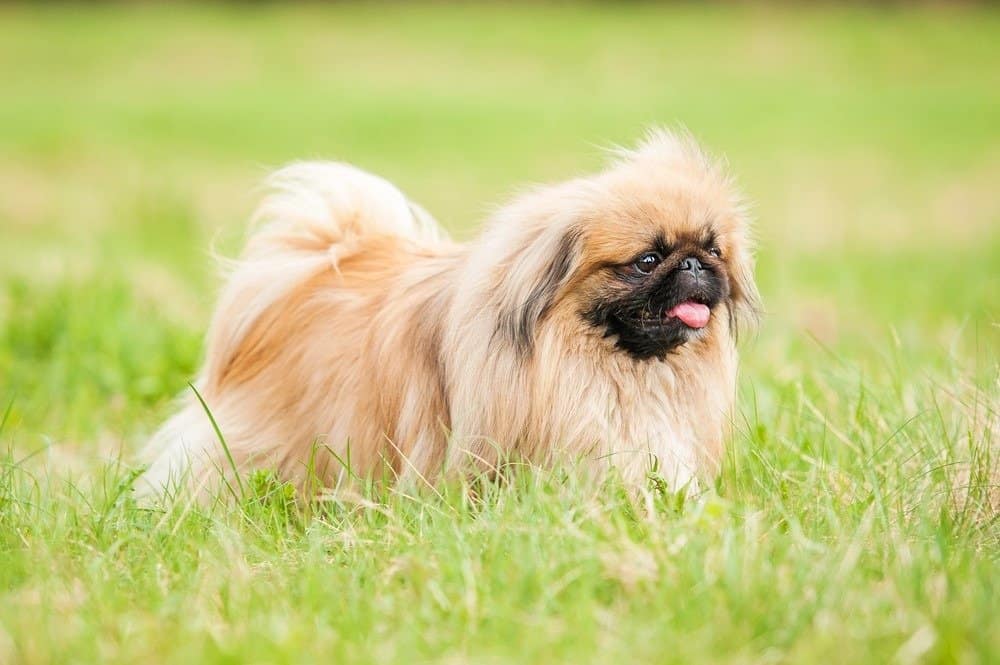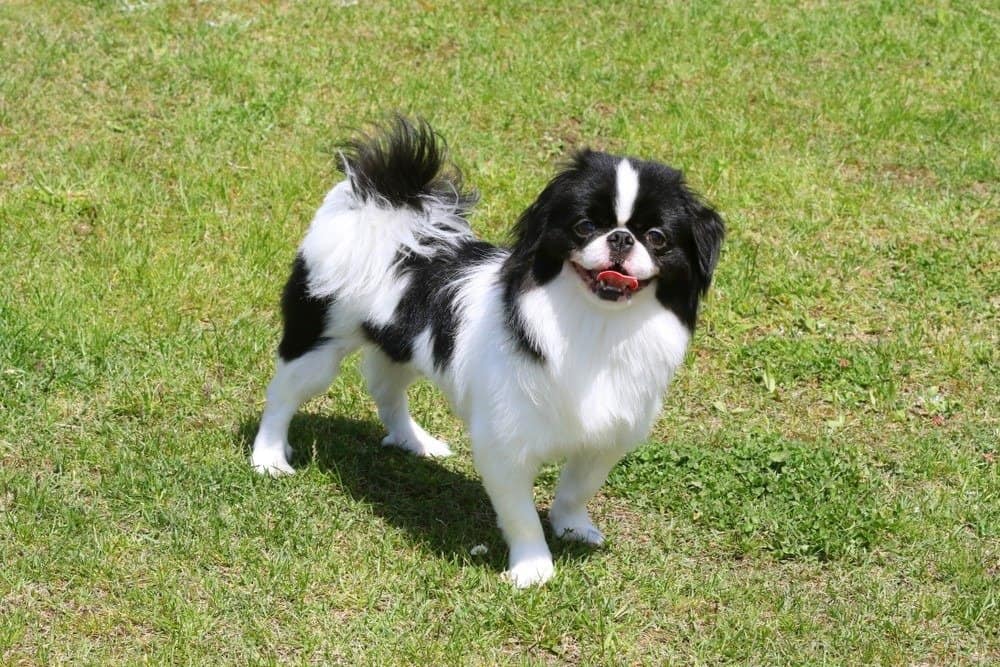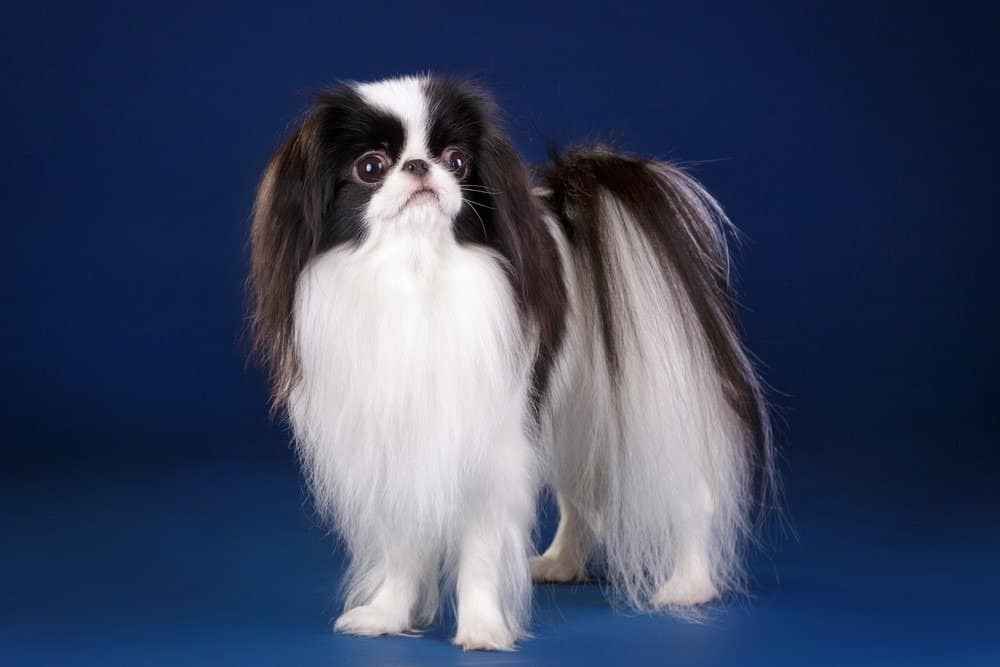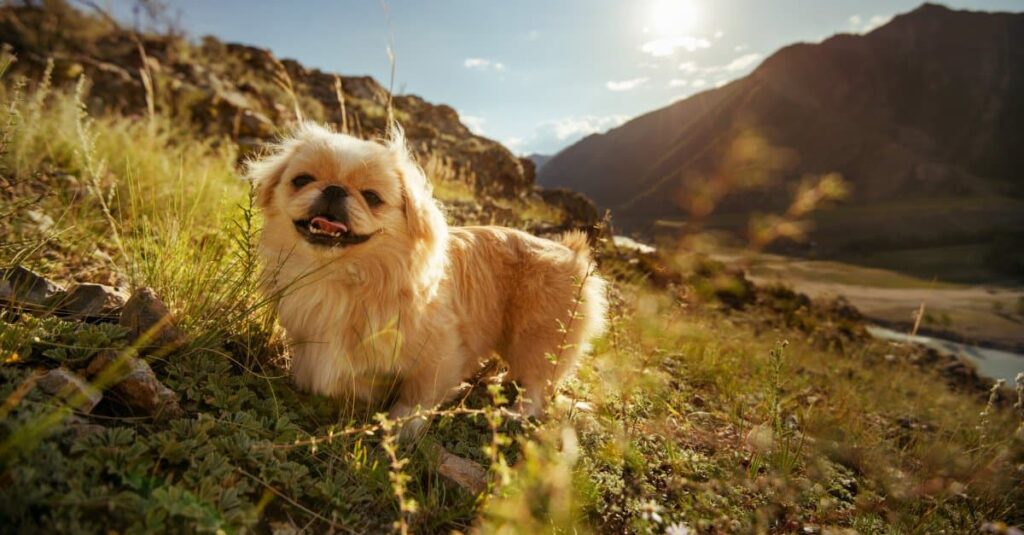Japanese Chins and Pekingese are toy dogs characterized by their long, straight fur, broad faces, and compact bodies. Studies show that Pekingese originated from China and were companion dogs for ancient Chinese imperial families. A Chinese legend says that the Pekingese once looked like a lion, but it asked Buddha to reduce its size after falling in love with a butterfly hence why it is also called lion dog.
On the other hand, Chins were presented as a gift to the Japanese Court. According to studies, ships sent to China and North Korea returned to Japan with Chins on board. In 1613, Searles, a British Captain, brought a Chin to England. In the 19th century, Japanese Chins became popular pets among upper-class ladies. Nowadays, they are considered companion dogs.
These two breeds may look similar, but several distinctive features can help you distinguish them.
Comparing Japanese Chin vs. Pekingese
| Japanese Chin | Pekingese | |
|---|---|---|
| Size | Weight: 7 to 11 lbs (3.2 to 5 kg) Height: 8 to 11 in (20 to 28 cm) | Weight: 7 to 14 lbs (3.2 to 6.3 kg) Height: 6 to 9 in (15 to 23 cm) |
| Color Variation | Black and white, black tan and white, lemon and white, red and white, sable and white, white and black | Biscuit, black, black & tan, cream, fawn, fawn brindle, gray, red, red brindle, red sable, white, fawn sable, gray sable, light red |
| Coat | Silky, straight, and long; its body, except for the face, has profusely feathering hair | Moderately long, straight; rough top coat and thick, soft undercoat |
| Temperament | Clever, mild, and lovely | Fearless, loyal, aloof, not timid or aggressive |
| Trainability | Relatively easy to train | Stubborn and very hard to train |
| Life Expectancy | 12-14 years | 12-15 years |
The Key Differences Between Japanese Chin vs. Pekingese
The American Kennel Club recognized the Japanese Chin as a breed in 1888, while the Pekingese was recognized as a breed in 1906. These two breeds, originating from Asia, share common attributes like silky attractive fur and cute bodies. However, there are a few traits that tell them apart. Japanese Chins and Pekingese differ in terms of size, color, coat, temperament, life expectancy, and price.
Japanese Chin vs. Pekingese: Size

Pekingese grow 6 to 9 inches tall at the withers.
©Rita_Kochmarjova/Shutterstock.com
Japanese Chins and Pekingese are both toy dogs, but their sizes vary. Generally, adult Pekingese are a bit heavier, but Japanese Chins can grow slightly taller. On average, Japanese Chins are about 8 to 11 inches (20 to 28 cm) tall at the withers and weigh about 7 to 11 pounds (3.2 to 5 kg). The ratio of their height at withers should be equal to the length of their body. Pekingese, on the other hand, grow 6 to 9 inches (15 to 23 cm) tall at the withers and weigh 7 to 14 lbs (3.2 to 6.3 kg). The Pekingese is considered a small dog, while the Japanese Chin is considered extra small.
Japanese Chin vs. Pekingese: Color Variation

The American Kennel Club has standardized six color variations for Japanese Chins.
©Rin Seiko/Shutterstock.com
The elegant and soft hair of a Japanese Chin is characterized by black or white color with red markings. Various color combinations are possible, but the American Kennel Club has standardized six color variations for Japanese Chins: black and white, black tan and white, lemon and white, red and white, sable and white, and white and black.
Breed standards are guidelines on ideal characteristics to be followed when judging animals at shows. Normally, a parent breed club will set a certain standard, and then it will be accepted internationally.
Pekingese have many color variations. There are 11 standard color variations established by the American Kennel Club: biscuit, black, black & tan, cream, fawn, gray, red, red sable, white, fawn sable, gray sable.
Japanese Chin vs. Pekingese: Coat

The Japanese Chin is known for its silky, straight, and long hair.
©Natalia Fedosova/Shutterstock.com
The Japanese Chin is known for its silky, straight, and long hair. Its ears, neck, thighs, and tail are covered with profuse hair with a feather-like texture. Its face, head, and forelegs are covered with short hair. It is an indoor dog and sheds seasonally. One would think the Japanese Chin requires high maintenance, but grooming is relatively easy. Brushing it once a week and washing them once a month should be enough.
On the other hand, the Pekingese has moderately long straight hair with a mane. It has a double coat that sheds seasonally. The undercoat is soft, and the top coat is coarse. The Pekingese also requires a huge amount of maintenance. It requires brushing and detangling two to three times a week. If you want to avoid matting, you should brush, detangle, and remove its loose hair using a slicker brush or a metal comb.
Japanese Chin vs. Pekingese: Temperament and Trainability
The Japanese Chin is a smart, calm, and lovely dog. It’s friendly with other dogs. This dog behaves well around older children, but due to its size, it can be seriously injured by younger kids. Japanese Chins will only bark if necessary, usually to alert their owners. Japanese Chin training should start early. These dogs are very agreeable and relatively easy to train.
The Pekingese is a fearless and loyal dog. It tends to be aloof but not timid or aggressive. It is better if it’s supervised when playing with children and other dogs. Pekingese rarely bark. On the other hand, they can be very stubborn, so training them might be challenging.
Japanese Chin vs. Pekingese: Life Expectancy

A healthy Pekingese will live 12 to 15 years.
©iStock.com/molchanovdmitry
On average, Pekingese live longer than Japanese Chins. A healthy Japanese Chin will live 12 to 14 years, while a healthy Pekingese will live 12 to 15 years. It is essential to screen your dogs for any underlying medical conditions while they are still puppies, so they can live their lives to the fullest.
Japanese Chin vs. Pekingese: Cost
A purebred Japanese Chincosts between $1,500 to $2,500. To ensure that the puppy you are getting is healthy and free from known genetic disorders, it is advisable to screen them.
Here are the recommended health screen tests for Japanese Chin:
- Patella Evaluation
- Cardiac Exam
- Ophthalmologist Evaluation
- GM2 Mutation DNA Test
Pekingese dogs are usually sold for approximately $750 – $3,500. According to The Pekingese Club of America, the Pekingese is amazingly devoid of genetic breed-related health issues. However, regular health exams are recommended to uncover and treat any potential problems that arise as they grow older.
Up Next:
The photo featured at the top of this post is ©
Ready to discover the top 10 cutest dog breeds in the entire world?
How about the fastest dogs, the largest dogs and those that are -- quite frankly -- just the kindest dogs on the planet? Each day, AZ Animals sends out lists just like this to our thousands of email subscribers. And the best part? It's FREE. Join today by entering your email below.
Sources
- Federation Cynologique Internationale, Available here: https://www.fci.be/en/nomenclature/JAPANESE-CHIN-206.html
- Federation Cynologique Internationale, Available here: https://www.fci.be/en/nomenclature/PEKINGESE-207.html
- American Kennel Club, Available here: https://www.akc.org/dog-breeds/japanese-chin/
- American Kennel Club, Available here: https://www.akc.org/dog-breeds/pekingese/
Thank you for reading! Have some feedback for us? Contact the AZ Animals editorial team.






